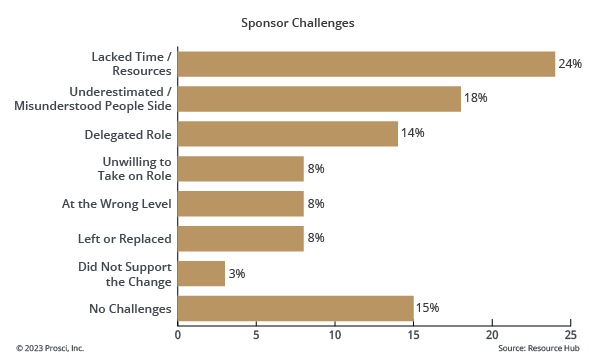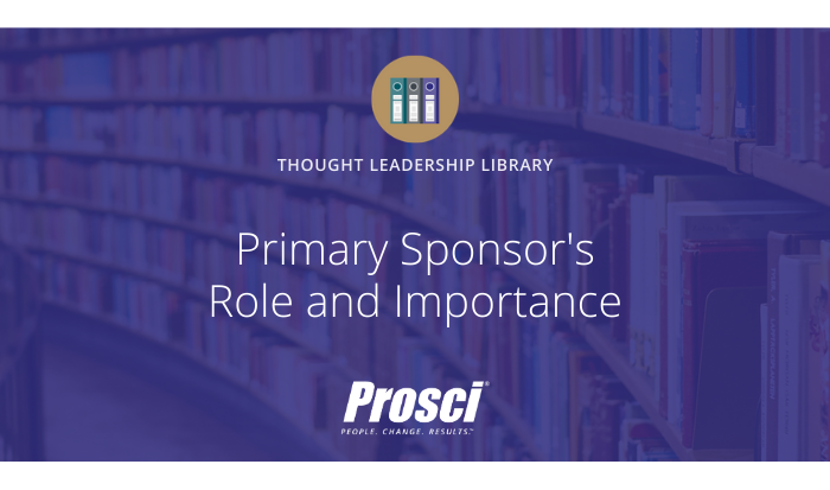Change Leaders, Do You Have Authority on Your Side?

4 Mins
Updated: February 23, 2024
Published: August 4, 2021

Do you have a primary sponsor named for your project but lack the true sponsorship support you need to succeed?
When project leaders and change practitioners are asked to name the number one factor in project success, they typically know the answer: active and visible sponsorship. In all of Prosci's Best Practices in Change Management research reports, active and visible sponsorship ranks as the top contributor to project success and has been cited four times more often than any other factor. Yet, despite a large percentage of projects having a named primary sponsor, many change practitioners lack the true sponsorship they need for success.
Do you understand your responsibility for enabling sponsors during change?
Equip yourself with details and research in this article"
Primary Sponsor's Role and Importance
Why You Need
True Sponsorship During Change
To understand why the role of the primary sponsor is important to achieving successful change, consider what the role really entails. Change leaders need primary sponsors to fulfill all of the ABC's of Sponsorship:
- Active and visible participation throughout the project
- Build a coalition of sponsorship
- Communicate support and promote the change to impacted groups
When this level of sponsorship is lacking, change leaders often experience:
- Increased resistance from employees, including key people managers in the organization
- Unavailable resources to support the project
- Slow adoption of the change or complete rejection of the change by some parts of the organization
Sponsor in Name or in Practice?
Consider a project you're supporting today. If you agree with the statements above and a senior leader has agreed be your primary sponsor, you might assume you are good to go. Unfortunately, the research does not support this assumption. Over the last two decades, Prosci research participants have cited ineffective change sponsorship as a top obstacle to change for a variety of reasons, such as:
- The sponsor was at the wrong level or in the wrong part of the organization to support this change (i.e., the sponsor lacked control over the people and systems impacted by the change).
- The sponsor was invisible (i.e., the sponsor did not get involved with the project team or communicate to employees).
- The sponsor did not build a coalition of sponsorship with other business leaders (and as a result, the change team encountered resistance from managers throughout the organization).
- The sponsor wavered in their support midway through the project (or found a different project that took priority).
- The sponsor did not manage the resistance that surfaced during the change.
In the 12th Edition of Prosci's Best Practices in Change Management research study, participants cited the following sponsor challenges:
 The upshot? Assigning a senior leader to the role of primary sponsor does not constitute effective sponsorship.
The upshot? Assigning a senior leader to the role of primary sponsor does not constitute effective sponsorship.
Sponsorship Checklist
The checklist below is a simple tool that can help you determine whether you are well-positioned to have the authority necessary for change success. Score each question on a scale of one to five, where one represents "no" or complete disagreement with the statement, and five represents "yes" or complete agreement with the statement.
If you score between 40 and 50 and you scored the first three questions a 4 or 5, your project likely has the elements for effective sponsorship. A score below 30 indicates that your project lacks the effective sponsorship required for successful change.
| Statement | Score |
| My sponsor has the ability to provide the needed resources and funding for the project. | 1 - 5 |
| My sponsor has direct control over the people and processes being impacted by this change. | 1 - 5 |
| My sponsor has direct control over the systems and tools being impacted by this change. | 1 - 5 |
| My sponsor is willing and able to be active and visible throughout the entire project. | 1 - 5 |
| My sponsor will build a coalition of sponsorship with key leaders and stakeholders in the organization. | 1 - 5 |
| My sponsor will manage resistance from other managers and remove barriers to the success of the project. | 1 - 5 |
| My sponsor will communicate directly to employees about why this change is being made and the risk of not changing. | 1 - 5 |
| My sponsor will implement the necessary reinforcements to sustain the change, including modifications to performance objectives and performance evaluations, and rewards and recognition for employees who adopt the change. | 1 - 5 |
| My sponsor is credible and respected by employees and managers within the organization (i.e., employees embrace the leadership of this individual). | 1 - 5 |
| My sponsor will remain in the organization throughout the implementation of this change. | 1 - 5 |
| Total score: |

How to Remedy Ineffective Sponsorship
If you scored low on the sponsorship checklist, take action to address the root cause:
A low score on any of the first three questions means your sponsor is probably not at the right level, given the scope of your project. In this case, a careful assessment of the sponsor coalition would determine if this project is in jeopardy. If you determine that your sponsorship coalition is also weak, you have two options:
- Identify the right person to sponsor this initiative and begin to build the necessary sponsor coalition.
- Redefine the scope of your project to fit or align with the sponsorship you do have.
Simply continuing with the project is not typically a viable option because the consequences will negatively affect the organization and your people, and your risk of project failure is high.
A low score on questions 4 through 8 means your sponsor needs coaching on the role of the primary sponsors during change. You may have a sponsor who is willing but does not know what effective sponsorship means, or you could have a sponsor who prefers not to be directly involved. The latter issue is harder to overcome, but with the right information and approach, most sponsors quickly see the importance of their role and get on board. Other the other hand, if your sponsor is willing but uneducated about the role of effective sponsorship, the change leader should directly coach and assist the sponsor to execute the role.
A low score on questions 9 or 10 likely means you need special tactics for approaching the project, including careful use of a strong sponsor coalition to carry a strong message to employees and be there throughout the entire project. If your sponsor is on a fixed term, such as with military organizations or government agencies, you may want to consider breaking the project into phases and focus on the phase that falls within the term limit of that sponsor.
Your Role in Effective Sponsorship
Having a primary sponsor named for your change and having the required sponsorship for successful change are not the same thing. Most executives and senior leaders lack understanding about how to be an effective primary sponsor of change—and that's to be expected because change management is not their primary role in the organization. Fortunately, that's where you come in. As a change practitioner, it's your job to enable your sponsor, so they are prepared and equipped to execute the critical actions needed for change success.


